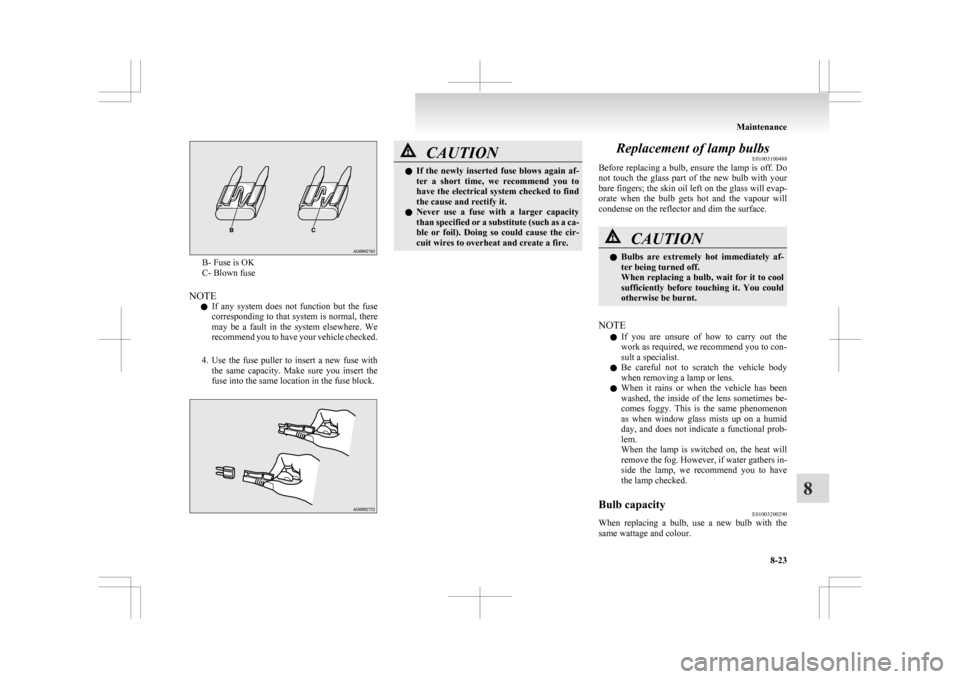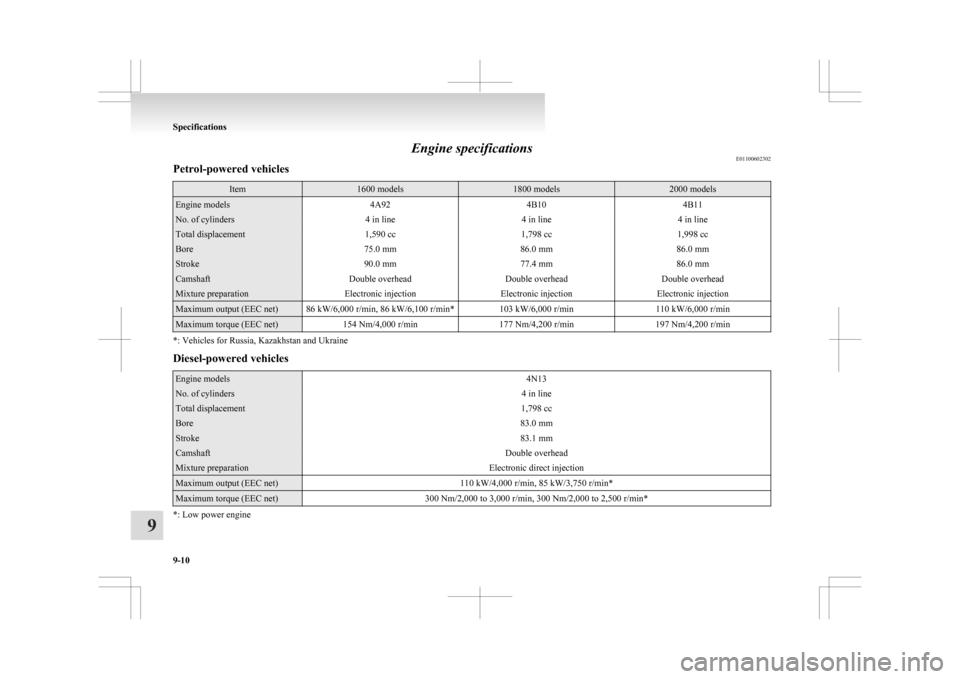Page 328 of 368

No. Symbol Electrical system Capaci-
ties
17 Head-
lamp low
beam
(right) Dis-
charge 20 A
18 Head-
lamp low
beam (left) Halogen 10 A
19 Head-
lamp low
beam
(right) Halogen 10 A
20 ENG/POWER 10 A
21 Ignition coil 10 A
22 ENG/POWER 20 A
Fuel line heater 25 A
23 Fuel pump 15 A
24 Starter 30 A*
25 — ——
26 Anti-lock brake
system 40 A*
27 Anti-lock brake
system 30 A* No. Symbol Electrical system Capaci-
ties
28 Air conditioning
condenser fan mo- tor 30 A*
29 Radiator fan motor 40 A*
30 IOD IOD 30 A
31 Audio system amp 30 A
32 Diesel 30 A
33 — Spare fuse 10 A
34 — Spare fuse 15 A
35 — Spare fuse 20 A *: Fusible link
l Some
fuses may not be installed on your ve-
hicle, depending on the vehicle model or spec-
ifications.
l The table above shows the main equipment
corresponding to each fuse.
The fuse box does not contain spare 7.5 A, 25 A or
30 A fuses. If one of these fuses burns out, substi-
tute with the following fuse.
7.5 A: 10 A spare fuse
25 A: 20 A spare fuse
30 A: 30 A audio system amp fuse
When using a substitute fuse, replace with a fuse of
the correct capacity as soon as possible. Identification of fuse Capacity Colour
7.5 A Brown
10 A Red
15 A Blue
20 A Yellow
25 A Natural (White)
30 A Green (fuse type)/
Pink (fusible link type)
40 A Green (fusible link type) Fuse replacement
E01007800630
1. Before replacing a fuse, always turn off the
electrical circuit concerned and turn the igni-
tion switch to the “LOCK” position or put
the operation mode in OFF.
2. Remove the fuse puller (A) from the inside of the fuse box in the engine compartment. 3. Referring
to the fuse load capacity table,
check the fuse pertaining to the problem. Maintenance
8-22
8
Page 329 of 368

B- Fuse is OK
C- Blown fuse
NOTE l If
any system does not function but the fuse
corresponding to that system is normal, there
may be a fault in the system elsewhere. We
recommend you to have your vehicle checked.
4. Use the fuse puller to insert a new fuse with the same capacity. Make sure you insert the
fuse into the same location in the fuse block. CAUTION
l
If
the newly inserted fuse blows again af-
ter a short time, we recommend you to
have the electrical system checked to find
the cause and rectify it.
l Never use a fuse with a larger capacity
than specified or a substitute (such as a ca-
ble or foil). Doing so could cause the cir-
cuit wires to overheat and create a fire. Replacement of lamp bulbs
E01003100488
Before
replacing a bulb, ensure the lamp is off. Do
not touch the glass part of the new bulb with your
bare fingers; the skin oil left on the glass will evap-
orate when the bulb gets hot and the vapour will
condense on the reflector and dim the surface. CAUTION
l
Bulbs
are extremely hot immediately af-
ter being turned off.
When replacing a bulb, wait for it to cool
sufficiently before touching it. You could
otherwise be burnt.
NOTE l If
you are unsure of how to carry out the
work as required, we recommend you to con-
sult a specialist.
l Be careful not to scratch the vehicle body
when removing a lamp or lens.
l When it rains or when the vehicle has been
washed, the inside of the lens sometimes be-
comes foggy. This is the same phenomenon
as when window glass mists up on a humid
day, and does not indicate a functional prob-
lem.
When the lamp is switched on, the heat will
remove the fog. However, if water gathers in-
side the lamp, we recommend you to have
the lamp checked.
Bulb capacity E01003200290
When replacing a bulb, use a new bulb with the
same wattage and colour. Maintenance
8-23 8
Page 342 of 368
Vehicle labeling
E01100102785
Vehicle identification number
The
vehicle identification number is stamped on
the bulkhead as shown in the illustration. Vehicle information code plate
The
vehicle information code plate is riveted as
shown in the illustration. The plate shows model code, engine model, trans-
mission model and body colour code, etc. Please use this number when ordering replacement
parts.
1- Model code
2-
Engine model code
3- Transmission model code
4- Body colour code
5- Interior code
6- Option code
7- Exterior code Vehicle identification number plate
(RHD vehicles only)
The
vehicle identification number is stamped on
the plate riveted to the left front corner of the vehi-
cle body. It is visible from outside of the vehicle
through the windscreen. Engine number
The
engine number is stamped on the engine cylin-
der block as shown in the illustrations.
Petrol-powered vehicles
1600 models *: Front of the vehicleSpecifications
9-02
9
Page 346 of 368
Vehicle performance
E01100301924
Petrol-powered vehicles Maximum speed 1600 models
183 km/h (114 mph)1800 models
186 km/h (116 mph)2000 models 2WD
194 km/h (121 mph) 4WD M/T
192 km/h (120 mph) CVT
188 km/h (117 mph)Diesel-powered vehicles
Maximum speed 2WD
200 km/h (124 mph), 188 km/h* (117 mph)4WD
198 km/h (123 mph), 185 km/h* (115 mph)*: Low power engineSpecifications
9-06
9
Page 350 of 368

Engine specifications
E01100602302
Petrol-powered vehicles Item 1600 models 1800 models 2000 models
Engine models
4A924B104B11No. of cylinders
4 in line4 in line4 in lineTotal displacement
1,590 cc1,798 cc1,998 ccBore
75.0 mm86.0 mm86.0 mmStroke
90.0 mm77.4 mm86.0 mmCamshaft
Double overheadDouble overheadDouble overheadMixture preparation
Electronic injectionElectronic injectionElectronic injectionMaximum output (EEC net) 86 kW/6,000 r/min, 86 kW/6,100 r/min* 103 kW/6,000 r/min
110 kW/6,000 r/minMaximum torque (EEC net)
154 Nm/4,000 r/min177 Nm/4,200 r/min197 Nm/4,200 r/min*: Vehicles for Russia, Kazakhstan and Ukraine
Diesel-powered vehicles
Engine models
4N13No. of cylinders
4 in lineTotal displacement
1,798 ccBore
83.0 mmStroke
83.1 mmCamshaft
Double overheadMixture preparation
Electronic direct injectionMaximum output (EEC net)
110 kW/4,000 r/min, 85 kW/3,750 r/min*Maximum torque (EEC net)
300 Nm/2,000 to 3,000 r/min, 300 Nm/2,000 to 2,500 r/min**: Low power engineSpecifications
9-10
9